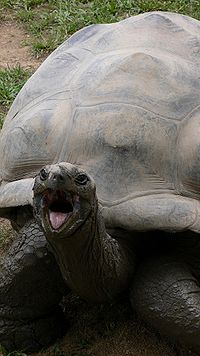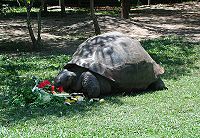- Harriet (tortoise)
-
This article is about the tortoise. For the name, see Harriet (name). For the record label, see Harriet Records. For the singer, see Harriet (singer).
Harriet (c. 1830 - June 23, 2006) was a Galápagos tortoise (Geochelone nigra porteri) who had an estimated age of 175 years at the time of her death in Australia. Harriet is the third oldest tortoise ever authenticated, behind Tu'i Malila, who died in 1965 at the age of 188, and Adwaita, who died in 2006 at the estimated age of 255.[1]
She was reportedly collected by Charles Darwin during his 1835 visit to the Galápagos Islands as part of his round-the-world survey expedition, transported to England, and then brought to her final home, Australia, by a retiring captain of the Beagle. However, some doubt was cast on this story by the fact that Darwin had never visited the island that Harriet originally came from.
Contents
HMS Beagle
In August 1994, a historian from Mareeba published a letter in the local newspaper about two tortoises he remembered at the Botanic Gardens in 1922 and that the keepers of the time were saying that the tortoises had arrived at the Gardens in 1860 as a donation from John Clements Wickham, who was the First Lieutenant (and later Captain) of HMS Beagle under Fitzroy during the voyage of the Beagle in 1835.
Wickham actually brought three tortoises to Australia when he arrived after retiring from the Royal Navy in 1841; these lived at Newstead House from 1841 to 1860. Records show that the tortoises were donated to the Botanic Gardens in 1860 when Wickham retired as Government Resident of Moreton Bay (now Brisbane) and left Australia for Paris.
Some researchers claim that Wickham was in Australia in 1841 and did not visit England that year to pick up the tortoises. This differs from information published by Dr. C.G. Drury Clarke and others, who list him as being in England in 1841. Furthermore, the British Hydrographic Department published maps of Wickham's surveys in 1841, indicating that he was in London that year. In addition, John Lort Stokes, who assumed command of the Beagle after Wickham, explicitly states in his book Discoveries in Australia, Volume 2 that Wickham departed to England after resigning his position as Captain.
There is evidence from letters that Charles Darwin was aware that Wickham had these tortoises, as he sent a letter to Huxley in 1860 informing him that he should speak with Wickham in Paris about the last of the tortoises from the 1835 expedition because he had them. This makes it at least possible that the three tortoises at the Brisbane Botanic Gardens were personally collected by Darwin.
It is thought that as many as 40 tortoises were stowed aboard the Beagle. Some were turned into meals, others were kept as souvenirs by crew members, a few as scientific specimens. Once the Beagle returned to England, the care of these large creatures became burdensome, so they were adopted by a local museum. There is no evidence that Darwin kept any of them as a pet in his home.
Harriet's subspecies
That the subspecies Harriet represents was not from one of the islands visited by Darwin is not actually problematic. Darwin definitely collected tortoises on San Cristobal, San Salvadore, and Santa Maria; however, the subspecies on Santa Maria (G. n. nigra) was, in fact, already nearing extinction when Darwin visited the islands, having been killed and eaten by prisoners on the prison colony there. Yet Darwin still collected tortoises on Santa Maria: the tortoises he found had been retrieved by the prisoners from other islands for food and Darwin collected some of these before they reached the stewpot. Hence they were a mixture of subspecies from a number of islands. Harriet, as a G. n. porteri, is from Santa Cruz. One of the other tortoises (Tom) is still in the Queensland Museum and has been identified as a G. n. chathamensis (from San Cristobal).
Other theories about Harriet
An initial analysis of Harriet's DNA was unable to identify her subspecies in a cross section of 900 animals representing 26 extant and extinct populations. After reanalysis she was assigned to G. n. porteri. However, her genetic diversity and other factors in her DNA sequence data indicated she was most likely at least two generations removed from the oldest specimens of her subspecies in the dataset. The oldest G. n. porteri in the dataset were collected as adults in 1907 and, hence, this would require Harriet to be born by 1860.
This dating rules out many alternate possibilities for Harriet as, prior to 1900, Australia was a very difficult place to get to. There were only two imports of Galápagos tortoises prior to 1900, and four of the five animals involved have been accounted for and are still represented by museum material. The suggestion in some quarters that Harriet was collected by whalers and brought to Australia is not likely, as Australia had its own whaling industry and whaling ships from South America did not visit Australia.
The tortoises collected by Darwin were all recorded in Fitzroy's journals of the voyage, including their measurements. As they averaged 11 inches (280 mm) in length, and this represented an approximate age of 5 years for the subspecies, Harriet's year of birth was estimated by Scott Thomson to 1830, with an error of 2 years either way, in the 1995 paper describing the events of Harriet's life and the results of the research.
Some also believe that Harriet was left with the Yabsley family of Coraki who were also on the Beagle.
Later life
Harriet was thought to be male for many years and was actually named Harry after Harry Oakman, the creator of the zoo at the Brisbane Botanic Gardens, but this was corrected in the 1960s by a visiting director of Hawaii's Honolulu Zoo. (As it happens, Tom, the specimen in the Queensland Museum, was also a female.)
On November 15, 2005, her much publicized 175th birthday was celebrated at Australia Zoo. This event was attended by Scott Thomson (the researcher on Harriet's history), three generations of the Fleay family, Robin Stewart (author of Darwin's Tortoise), and many hundreds of others who knew this tortoise during the latter part of her life.
Harriet died in her enclosure on June 23, 2006, of heart failure following a short illness.
Character
Harriet was said to be very good-natured. She loved the attention of humans and enjoyed it when people patted her on the scute. Harriet spent a majority of her day napping at her home pond. Her favourite food was hibiscus flowers.
Timeline for Harriet
(see Thomson, Irwin and Irwin (1995))
- ca. 1828–1832: Harriet hatches, probably on Santa Cruz.
- 1835: Harriet is probably collected by Charles Darwin and taken to England.
- 1841: Wickham retires from the Royal Navy, moves to Australia and brings three tortoises with him. Lives at Newstead House.
- 1859: First publication of Darwin’s Origin of Species.
- ca. 1860: Probable time when the three tortoises are placed in the Brisbane Botanical Gardens as Wickham soon left Australia for France.
- ca. 1870: The earliest first-hand account of Harriet.
- 1882: Charles Darwin dies.
- 1942: Tom – one of the original three tortoises – dies, and is placed in the Queensland Museum.
- 1952: Harriet moves to Fleay’s Fauna Sanctuary.
- 1987: Harriet moves to the Queensland Reptile Park (Australia Zoo).
- 1995: Harriet's remarkable history and the results of the research are presented.
- 2005: Harriet's 175th birthday is attended by many people who had a long association with her.
- 2006: On June 23, Harriet dies of heart failure at Australia Zoo.
See also
References
- Harriet finally withdraws after 176 years - Sydney Morning Herald, Friday, 23 June 2006
- BBC News: Zoo celebrates Harriet the tortoise's 175th birthday
- ABC News: Harriet Dies
- Harriet the Tortoise dies at 175 - BBC News, Friday, 23 June 2006
- Story at Mirror.co.uk with Harriet timeline
External links
Individual non-fictional turtles Categories:- Individual tortoises
- 1830 animal births
- 2006 animal deaths
Wikimedia Foundation. 2010.


